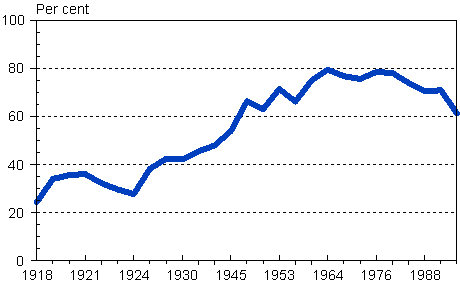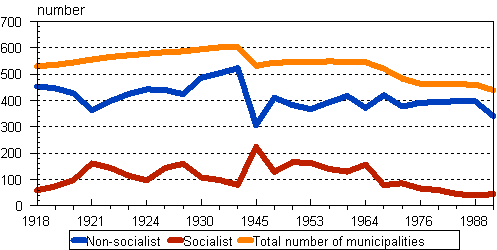Municipal elections 1918-1996
The 1917 Act on rural municipalities and cities stipulated that municipal decision making and auditing in cities, urban districts and urban municipalities should be carried out by councillors and auditors elected in elections based on universal and equal suffrage.
In the beginning, municipal elections were held once a year, as one third of the seats were up for election on the 4th of December each year. In 1925, the election period was extended to three years, and councils were given the right to elect auditors. In 1955, the election period was extended to four years.
The first elections under the Act on municipal elections were scheduled for 1917, but they had to be postponed due to the general strike in November that year. In the aftermath of the Civil War the following year, elections were finally held in December 1918 and January 1919. All subsequent municipal elections have been held at the election date determined by law.
Voting turnout
Voting turnout in municipal elections has never reached the same levels as in parliamentary elections. Participation in municipal elections grew at steady pace from a low of 24.5 per cent in 1918 to a high of 79.4 per cent in 1964. After that, voting turnout has declined. The difference between voting turnout in parliamentary elections and municipal elections was over 30 per cent during the early years of Finland's independence. Over time, this difference has diminished to around 10 per cent in the 1990s.
Figure 1. Voting turnout in municipal elections 1918-1996, (%)

Including Åland, where the municipal election date differs
from that on the mainland, due to regional legislation.
Source: Statistics Finland, Election statistics
Eligible voters
Under the Local Government Act presently in force (1995/365), the number of councillors varies from 17 in municipalities with less than 2,000 residents, to 85 in municipalities with more than 400,000 residents. By special permission, the minimum number of councillors can be lowered to 13. The council is elected in direct and proportional elections conducted every four years on the 3rd Sunday in October.
Every 18-year-old Finnish citizen is eligible to vote in a municipal election. Eligibility extends to the citizens of the Member States of the European Union as well as Norway and Iceland, provided that they have been residents of the municipality for 51 days prior to the election day. Other foreign citizen is also eligible to vote, provided that he or she is a resident of the municipality and has been a resident of Finland for the past two years.
Political balance of power
Prior to 1968, the analysis of election results focused mainly on the balance of power between non-socialists and socialists. The plethora of candidate lists and election alliances prevented a more detailed analysis along party lines. The 1969 Party Act provided a clearer view of the electoral field by making candidate nomination chiefly a party prerogative. The non-socialist/socialist dichotomy was replaced by a breakdown by party in the 1968 official election statistics. This classification has become less relevant with the fading of the (class-based) left/right division of the party field.
The parties on the right have attained a majority of the votes in all municipal elections, and thus a majority of all council seats, which are proportional to the parties' share of votes. Parties on the left have been underrepresented, due amongst other things, to the lack of election alliances on the left. The majority obtained by the parties on the right has not been overly great, but it is very evenly distributed in all parts of the country.
Figure 2. Number of municipal councils with non-socialist and socialist majority, respectively, and the total number of municipalities 1918-1992

The 1996 municipal elections are not included, due to
missing data.
Source: Statistics Finland, Election Statistics
Sources:
Nousiainen, Jaakko: Suomen poliittinen järjestelmä, (The Finnish
political system, in Finnish only) 1992, WSOY, Juva
Suomen Historian Pikkujättiläinen, (Concise history of Finland, in
Finnish only) 4th edition, 1990, WSOY, Porvoo
Statistical Yearbook of Finland 1931, 1946-1947, 1948 and 1998
(1998 table in English)
Tarasti, Lauri: Suomen vaalilainsäädäntö, (Finnish electoral
legislation, in Finnish only) 1987, Edita, Helsinki
Tilastokatsauksia I-II, (Statistical overviews, in Finnish and
Swedish), 1924-1925, Central Statistical Office of Finland, Council
of State Printing Press, Helsinki
Official Statistics of Finland, XXIX, Elections, Municipal
elections 1921-1928, 1964, 1968, 1972, 1976, 1980, 1984, 1988, 1992
and 1996 (Table headings in English from 1956 onwards).
Last updated 31 May 2004
Official Statistics of Finland (OSF):
Municipal elections [e-publication].
ISSN=2323-1114. 2000,
Municipal elections 1918-1996
. Helsinki: Statistics Finland [referred: 19.4.2024].
Access method: http://www.stat.fi/til/kvaa/2000/kvaa_2000_2004-05-31_kat_003_en.html

